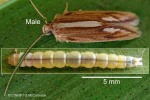Cook Islands Biodiversity Database
Species Page
Agonoxena argaula
Coconut Flat-Moth
Multimedia & Additional Resources
| Type | Description | Download |
| Adult male and larva | 61KB | |
| Adult male, female, larva and eaten leaf | 53KB |
General Information
Cook Islands Distribution
| Southern Group: Present Makatea: Present | ||||||||
RR |
MG |
AT |
MK |
MT |
AK |
PL |
TK |
MN |
P |
P |
P |
P |
P |
P |
P |
- |
- |
| Northern Group: - | |||||
TN |
MH |
RK |
PK |
NS |
SW |
- |
- |
- |
- |
- |
- |
Pests & Hosts
| Relationship | Pests |
| Parasitoid (biocontrol) of caterpillars | Brachymeria QQMP, Bracon QQFiji, Eupelmus QQMP, Hockeria QQMP, Trichospilus diatraea, |
Scientific Taxonomy
Agonoxena argaula Meyrick
TAXONOMY: ANIMALIA; ARTHROPODA; ATELOCERATA; HEXAPODA; INSECTA; PTERYGOTA; Lepidoptera; AGONOXENIDAE
More Information
SIGNIFICANCE NOTES -
NEGATIVE SIGNIFICANCE: Pest - serious. Comments: "In October 2000 the Ministry of Agriculture (MoA) was informed about unhealthy-looking, dying coconut trees with dry leaves in the south east side of Rarotonga. During a survey caterpillars were found feeding on mature leaves causing severe damage. Samples of both caterpillars and emerging adults were identified by CAB International as Coconut Flat Moth Agonoxena argaula.
In January 2001 the affected area on Rarotonga covered about 2 sq.km . The moth is not recorded from other islands in the Southern or Northern Group of the Cook Islands.
In the South Pacific the pest is recorded from Fiji, Kiribati, Nauru, New Caledonia, Niue, American Samoa and Samoa, Tokelau, Tonga, Tuvalu, Vanuatu, Hawaii, Wallis and Futuna Islands. It is not known to occur in French Polynesia, Solomon Islands or Papua New Guinea.
On Rarotonga two parasitoids were reared from field collected pupae and identified by CAB International as Brachymeria sp. and Trichospilus diatraea. The former is also recorded from other Pacific Islands; the latter is a new record from the Cook Islands. On average Brachymeria sp. parasitised about 50% of the pupae; 5% were attacked by T. diatraeae." [SPC Pest Alert #21, 3 April 2001]
Within three years despite internal quarantine regulations and public awareness the pest spread to all other Southern Group Islands, except Mitiaro. Confirmations dates were: Aituaki July 2002, Atiu August 2002, Mauke November 2002, Mangaia January 2003, and Palmerston March 2003. In all, five wasps have been found to parasitize the moth caterpillar. [Poeschko, MoA, Sept.2003] And present on Mitiaro November 2003. [Poeschko, MoA, 2/2005].
Vouchers & References
Vouchers:
Rarotonga: PRESENT Oct. 2000 per M.Poeschko in MoA report 2/2005 as Agonoxena argaula (see references). Mangaia: PRESENT Jan. 2003 per M.Poeschko in MoA report 2/2005 as Agonoxena argaula (see references). Atiu: PRESENT August 2002 per M.Poeschko in MoA report 2/2005 as Agonoxena argaula (see references). Mauke: PRESENT Nov. 2002 per M.Poeschko in MoA report 2/2005 as Agonoxena argaula (see references). Mitiaro: PRESENT Nov. 2003 per M.Poeschko in MoA report 2/2005 as Agonoxena argaula (see references). Aitutaki: PRESENT July 2002 per M.Poeschko in MoA report 2/2005 as Agonoxena argaula (see references). Palmerston: PRESENT March 2003 per M.Poeschko in MoA report 2/2005 as Agonoxena argaula (see references).
References:
Special Reference: M.Poeschko, Feb.2005, MoA report "Biological Control Programme of the Coconut Flat Moth Agonoxena argaula in the Cook Islands - Summary Report".
Data Update History (information):
zTX, zB02, zupB03b, zM02
Web Resources
Citation Information
McCormack, Gerald (2007) Cook Islands Biodiversity Database, Version 2007.2. Cook Islands Natural Heritage Trust, Rarotonga. Online at http://cookislands.bishopmuseum.org. ![]()
Please refer to our use policy.

